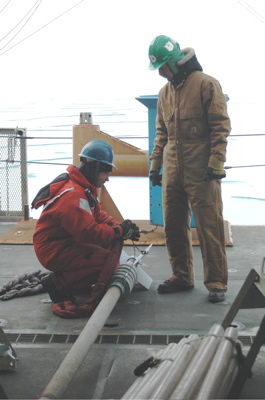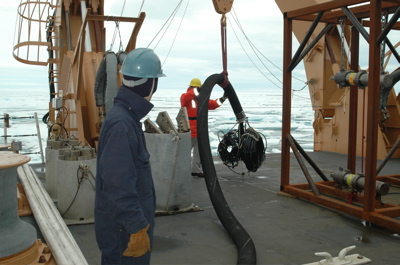( Log In ) Log In is for TREC Teachers & Researchers only
  |
| Steve_Stevenoski |
 Aug 3 2006, 12:56 AM Aug 3 2006, 12:56 AM
Post
#1
|
|
Member   Group: TREC Team Posts: 27 Joined: 19-July 06 Member No.: 39 |
July 29, 2006
Larry Phillips and the coring team worked through the night to collect two small Benthos cores. This was the first attempt of this cruise and all went pretty well. They still have some adjustments to make and a support platform for the coring gear needs to be mounted on the starboard side of the ship, but we some good cores. Larry Phillips will catalog these cores over the next few days. They will be prepared and stored for future analysis and study. Setting up the benthos corer  Preparing to take the first core  This morning he helicopters were flying. The weather was cooperating just enough to make it possible to deploy the first set of instruments out on the ice. The\re was a slight mist, but visibility was acceptable. The first flight at 7:25 was to do an ice recon and to deploy one instrument. If the ice and weather were good, they would make a second flight. By 10:15 they had finished a second flight and now had four instruments deployed. While helicopter operations were winding down and as we got going on the seismic cage for another day, I had a chat with Kevin and Matt about people, relationships, dating and women. It has been a long time since I have been in the dating scene, and it was interesting to hear about their thoughts and ideas. After our lively discussion we sat down with Dale to plan the day and make a list of all the tasks that had to be completed before the guns and cage could be operational and deployed safely. Most of the work for today would be rigging hoses and cables for the guns in their proper locations in the cage. At 10:50, Larry came down to the lab looking for a volunteer victim. The Coast Guard was conducting a helicopter crash training simulation and the needed a victim. I headed up to the helicopter hanger and checked in with Dave the flight coordinator. He took me out to the helicopter on the flight deck. To make the simulation a bit more challenging, he strapped me in the pilots seat, put on my flight helmet and I waited to be saved. I asked him if I was unconscious as he closed the door, and he said, "Yes". Two people dressed in silver fire suites and hoods marched in step toward the helicopter. With pry bar in hand they approached my door then opened it. They then unbuckled then pulled me from the seat. In unison they slowly marched while carrying me to the medical area of the flight deck. All the while about 10 other Coast Guard personnel were manning fire hoses and coordinating the situation. It was very well planned and well implemented. They really had the bases covered and during the whole process they looked for ways to improve the whole operation. Saturday is inspection day and at about 12:50 when the third flight of the day left to deploy instruments, Matt and Kevin swept and swabbed the main lab deck. It was a quick flight and they were back in about an hour. In the mean time we organized for the afternoon. All of the hoses and wires in the tube had to be hoisted by crane up onto the cage. Once there it was secured and we started to pull out the excess wire and hose. Unfortunately for us in the lifting of the tube, the wires and hoses had become tangled and the angle of the tube as it draped off the 9-foot cage onto the deck just added to the mess. At Mark's suggestion, we repositioned the cage end of the tube, and hoisted the mid section. After a half hour of adjusting, we were able to pull out all the slack in the hoses and wires on the cage side, and began to make connections. Checking the lines and hoses on the air gun  Hoisting the hoses and wires to the top of the gun cage  We worked until midnight bundling the excess hose and wire into coils and running the free ends of the gun wires to the controller boxes. Mark and Dale stayed up for some time after midnight working on the connections. During this whole time the ship was on station. The watch standers still collected information throughout the whole day. We drifted with the Ice about 2 miles. Captain Russell stopped in at the main lab late in the evening to see how things were going. Talked a little about his travels and family. When you get wrapped up in the work, and it seems like your whole world is this 400-foot floating community, it is easy to forget that everyone here has a different life away from the ship and the science. |
  |
2 User(s) are reading this topic (2 Guests and 0 Anonymous Users)
0 Members:

|
NSF Acknowledgment & Disclaimer | Time is now: 17th November 2024 - 03:05 PM |
Invision Power Board
v2.1.7 © 2024 IPS, Inc.








